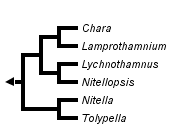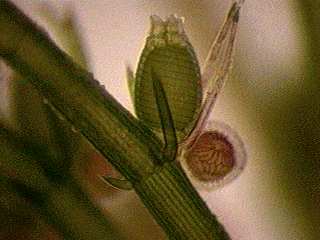Charales
Richard M. McCourt


This tree diagram shows the relationships between several groups of organisms.
The root of the current tree connects the organisms featured in this tree to their containing group and the rest of the Tree of Life. The basal branching point in the tree represents the ancestor of the other groups in the tree. This ancestor diversified over time into several descendent subgroups, which are represented as internal nodes and terminal taxa to the right.

You can click on the root to travel down the Tree of Life all the way to the root of all Life, and you can click on the names of descendent subgroups to travel up the Tree of Life all the way to individual species.
For more information on ToL tree formatting, please see Interpreting the Tree or Classification. To learn more about phylogenetic trees, please visit our Phylogenetic Biology pages.
close boxIntroduction
The green algae in the order Charales are commonly called stoneworts or brittleworts. These algae are common in quiet freshwater habitats such as ponds and streams; a few are found in brackish water. Stoneworts are found on all continents except Antarctica. The Charales are the only living stoneworts; two orders of extinct algae closely related to the Charales are known only from fossils of their reproductive spores. The thallus of the plant consists of a series of so-called "giant cells" up to several cm in length, with branches coming off at nodes composed of smaller cells. Growth occurs at the apex, and the plant is anchored in mud or silt by translucent rhizoids. Male and female sexual reproductive structures grow at the nodes. The male antheridia are spherical and often orange. The female oogonia are oblong, consisting of a central cell jacketed by five tubular, spiraling cells. A crown of smaller cells sits atop the jacket cells where they come together.
The thallus in some stoneworts is encrusted with white lime, giving a crusty texture (hence the name brittlewort). Often the thallus has a strong unpleasant smell, and the plants are sometimes called skunkweed.
Discussion of Phylogenetic Relationships
Six living genera in a single family, the Characeae are known. Chara and Nitella contain the most species. Conventional taxonomy (Wood and Imahori, 1965) divides the Charales into two tribes: tribe Chareae (Chara, Nitellopsis, Lamprothamnium, Lychnothamnus), and tribe Nitelleae (Nitella, Tolypella). The Chareae have a crown of five cells on the oogonium, whereas the Nitelleae have a crown of ten cells. Recent molecular studies using rbcL sequences (McCourt et al., 1996) supports the Chareae as a monophyletic group (with the topology shown), with Tolypella and Nitella basal to the group However, the rbcL data suggest that the latter two genera form a basal grade rather than a monophyletic tribe:
=== Chara
===|
| === Lamprothamnium
======|
| | === Lychnothamnus
=====| ===|
| === Nitellopsis
|
|=========== Tolypella
|
============ Nitella
References
McCourt, R. M., Karol, K. G., Guerlesquin, M., and Feist, M. (1996) Phylogeny of extant genera in the family Characeae (Charales, Charophyceae) based on rbcL sequences and morphology. Amer. J. Bot. (in press)
Wood, R. D., and K. Imahori. (1965) Monograph of the Characeae. First part of a revision of the Characeae. Verlag von J. Cramer, Weinheim.
Information on the Internet
Translation of this page into Estonian by Anna GalovichAbout This Page

Academy of Natural Sciences of Drexel University
Correspondence regarding this page should be directed to Richard M. McCourt at
Page copyright © 2011
All Rights Reserved.
- Content changed 22 November 2011
Citing this page:
McCourt, Richard M. 2011. Charales. Version 22 November 2011 (under construction). http://tolweb.org/Charales/20580/2011.11.22 in The Tree of Life Web Project, http://tolweb.org/








 Go to quick links
Go to quick search
Go to navigation for this section of the ToL site
Go to detailed links for the ToL site
Go to quick links
Go to quick search
Go to navigation for this section of the ToL site
Go to detailed links for the ToL site